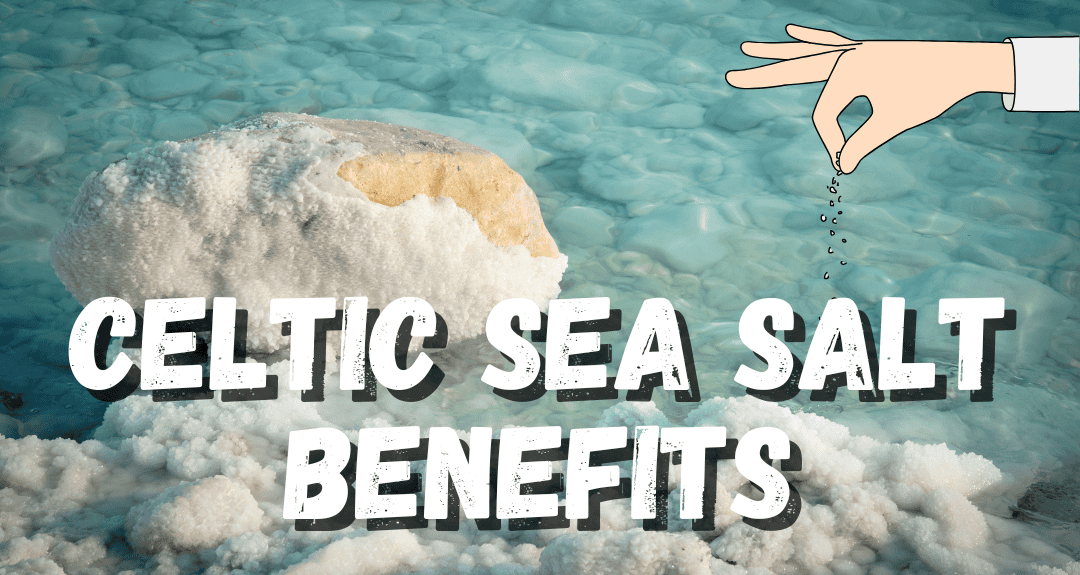Celtic salt, unlike ordinary table salt, is replete with minerals that can impact your health dramatically. This nutrient-rich salt is a superfood, not just a seasoning, with benefits including hydration and nutrition for your skin!
In this guide, we’ll explore the benefits of using Celtic sea salt, uses, and also how to make Celtic salt water so that you get the best results. Prepare to unleash the power of nature’s most pure salt!
Celtic Salt: A Unique Seasoning
Celtic salt isn’t your average seasoning. Unlike heavily processed table salt, it’s hand-harvested using centuries-old methods that preserve its natural mineral profile. Here’s why it stands out:
- Traditional Harvesting: Sun-dried in clay ponds, Celtic salt retains moisture and minerals like magnesium, potassium, and calcium.
- Mineral Richness: With 84+ trace minerals, it’s a nutrient-dense alternative to refined salts stripped of their natural benefits.
- Texture & Color: Its subtle grey hue and moist texture signal unprocessed purity—no anti-caking agents or bleach here.
Comparison of Celtic Salt vs. Table Salt
| Feature | Celtic Salt | Table Salt |
|---|---|---|
| Processing | Unrefined | Highly refined |
| Minerals | 84+ trace minerals | 2-3 minerals |
| Additives | None | Anti-caking agents |
| Moisture | Naturally moist | Dried |
Fun Fact: A study in the Journal of Food Science highlights unrefined salts as superior sources of essential minerals.
Celtic Salt in Drinking Water: How Much Should You Use?
Ever wondered why athletes swear by salted water? Celtic salt’s electrolytes—sodium, potassium, and magnesium—enhance hydration at a cellular level. Here’s how to use it wisely:
- Ideal Ratio: ¼ tsp per 16 oz of water. This mimics the body’s natural electrolyte balance.
- Morning Routine: Start your day with a glass to combat dehydration after sleep.
- Overuse Risks: Exceeding 1-2 glasses daily may lead to sodium overload. Balance with potassium-rich foods like bananas or spinach.
Pro Tip: Add a squeeze of lemon for vitamin C and a refreshing twist!
3. Seven Science-Verified Celtic Sea Salt Benefits
Celtic salt is more than just a new darling for the pantry—it’s a nutrient powerhouse, and its benefits are beginning to be substantiated by science. Here, we break down its most persuasive perks, from hydration hacks to glowing skin secrets.
1. Increases Hydration by Helping Cells Absorb More Water
Have you ever downed a ton of water and still felt parched? You can drink all the H2O you want, but your body needs electrolytes to absorb it. The sodium and potassium in Celtic salt act like “hydration gatekeepers,” assisting cells in holding onto water more efficiently. A 2020 study published in the Journal of the International Society of Sports Nutrition found that electrolyte-rich drinks improved hydration 40% faster than plain water.
Tap this: Sprinkle a few grains of Celtic salt in your water bottle before working out to stave off cramps and fatigue.
2. Natural Iodine for Thyroid Support
Your thyroid gland uses iodine to make hormones that control metabolism. While table salt is artificially iodized, Celtic salt provides a naturally balanced dose. One ¼ teaspoon contains approximately 50–70 mcg of iodine—around 30% of your daily requirements.
But keep in mind: If you have thyroid problems, speak to your doctor before relying solely on Celtic salt for iodine.
3. Stomach Acid Stimulation
Inadequate stomach acid can lead to bloating and indigestion. The chloride in Celtic salt activates hydrochloric acid, helping your body digest food more effectively. Dr. James DiNicolantonio, a cardiovascular researcher, writes in his book The Salt Fix that unrefined salts might improve gut health by enhancing digestion.
Here’s a pro tip: Before every meal, sip some Celtic salt (½ tsp) mixed in warm water to stimulate the digestive system.
RELATED POST: Lose Weight Fast: Science-Proven Trick You Must Try!
4. Balances pH Levels and Decreases Acidity
Contemporary dietary habits (think caffeine, sugar, and processed foods) often make our bodies more acidic. The alkaline minerals in Celtic salt—such as calcium and magnesium—work to neutralize excess acid. A 2017 study published in Nutrients found that diets rich in minerals help maintain optimal pH balance and reduce inflammation.
5. Enhances Bone Strength with Calcium and Magnesium
Surprise: Salt is not the enemy of bones! The calcium (1% per gram) and magnesium in Celtic salt support bone density. In fact, magnesium deficiency is associated with increased fracture risk, according to a study published in Osteoporosis International.
6. Minimizes Muscle Cramping through Electrolyte Replacement
Are your charley horses ruining your sleep? The magnesium and potassium in Celtic salt help relax muscles and prevent spasms. Athletes often use it post-workout—just mix ¼ tsp with water and a splash of orange juice for a DIY electrolyte drink.
7. Improves Nutrient Absorption in the Gut
Celtic salt also contains minerals such as zinc and iron, which act as cofactors that help your body absorb vitamins and nutrients from food. Think of it as a “multivitamin” for your digestive system!
Celtic Salt Health Benefits at a Glance
| Benefit | Key Minerals Involved | Practical Use |
|---|---|---|
| Hydration | Sodium, Potassium | Add to water pre-workout |
| Thyroid Support | Iodine | Use in place of table salt |
| Digestion | Chloride | Pre-meal saltwater tonic |
| pH Balance | Calcium, Magnesium | Daily cooking or seasoning |
| Bone Health | Calcium, Magnesium | Incorporate into meals |
| Muscle Recovery | Magnesium, Potassium | Electrolyte drink for after a workout |
| Nutrient Absorption | Zinc, Iron | Pair with vitamin-rich foods |
Did You Know? Its magnesium content can even improve the quality of sleep by soothing the nervous system.
Thoughts: Celtic salt is nutrient-dense, but it’s still salt. To avoid sodium overload, stick to 1.5–2.5 tsp daily (per WHO recommendations).
4. Why Celtic Salt Water is Hydration at Its Best
Stop guzzling sugary sports drinks or plain water, which can leave you flat. Celtic salt water is the original hydration hack—simple, natural, and full of the electrolytes your body craves. Let’s break down why this briny beverage is a game-changer for energy, endurance, and recovery.
How Sodium and Potassium Help Prevent Dehydration
Dehydration isn’t just about losing water—it’s about losing electrolytes. Sodium and potassium act as a cellular “tag team”:
- Sodium: Draws water into cells, keeping them plump and functional.
- Potassium: Maintains fluid balance within cells, preventing them from shriveling like raisins.
A 2018 study published in the Journal of Clinical Medicine found that electrolyte-enhanced hydration reduced muscle fatigue by 25% compared to plain water. The natural sodium-potassium ratio (about 1:1) in Celtic salt mirrors what your body truly needs, making it a smarter choice than processed alternatives.
Pro Tip: Is your energy lagging mid-afternoon? Replace coffee with a glass of Celtic salt water. The electrolytes help combat the “cellular dehydration” that caffeine often exacerbates.
RELATED POST: Glycemic Index (GI) of 100 Common Foods
Why Celtic Salt Water Beats Sports Drinks
Sports drinks are often marketed as hydration solutions, but many are neon-colored sugar bombs. Here’s why Celtic salt water stands above the rest:
| Feature | Celtic Salt Water | Sports Drinks |
|---|---|---|
| Electrolytes | Sodium, potassium, magnesium | Sodium, potassium (synthetic) |
| Added Sugars | 0g | 20–34g per bottle |
| Artificial Additives | None | Dyes, flavors, preservatives |
| Cost per Serving | ~$0.10 | ~$1.50–$3.00 |
Why it matters: The typical sports drink contains 6–8 teaspoons of sugar—enough to spike your insulin levels and derail hydration goals. Celtic salt water avoids these pitfalls, delivering trace minerals like zinc and iron to support metabolic function without the junk.
But Wait—Is This Safe for Everyone?
While Celtic salt water is less harsh than processed alternatives, moderation is key. The American Heart Association recommends no more than 2,300 mg of sodium per day, equivalent to about 1 tsp of Celtic salt.
Note: If you have hypertension or kidney issues, consult your doctor before making Celtic salt water part of your routine.
5. Celtic Sea Salt Benefits for Skin: A Natural Beauty Secret
Move over, luxury serums—Celtic salt is nature’s answer to glowing skin. Packed with minerals that detoxify, exfoliate, and heal, it’s a budget-friendly multitasker for your skincare routine. Let’s explore how to harness its magic!
DIY Face Scrubs for Exfoliation & Acne Reduction
Celtic salt’s fine grains slough off dead skin without the harshness of microbeads. Its antibacterial properties, courtesy of zinc and magnesium, combat acne-causing bacteria effectively.
Simple Scrub Recipe:
- 1 tbsp Celtic salt
- 1 tsp raw honey (antibacterial)
- ½ tsp coconut oil (moisturizing)
Mix ingredients, gently massage onto damp skin, rinse, and pat dry. Use 1–2x weekly.
Caution: Avoid use if you have active breakouts or sensitive skin—opt for a finer grind to prevent irritation.
Anti-Aging Properties from Mineral-Rich Detoxification
Celtic salt’s magnesium boosts collagen production, while calcium speeds up cell turnover for smoother, firmer skin. A 2019 study published in Dermatologic Therapy revealed that mineral-rich salts improve skin elasticity by 18% in just 8 weeks.
Pro Tip: Spritz a diluted Celtic salt water toner (1 tsp salt in 8 oz water) onto clean skin post-cleansing to tighten pores and brighten dullness.
Bath Soaks to Soothe Eczema & Psoriasis Flare-Ups
The anti-inflammatory minerals in Celtic salt, such as potassium and sulfur, calm itchy, inflamed skin. It’s a natural remedy for eczema and psoriasis symptoms.
Healing Bath Blend:
- 1 cup Celtic salt
- ½ cup Epsom salts
- 5 drops lavender oil (optional)
Dissolve in warm bathwater, soak for 15–20 minutes, then moisturize thoroughly.
User Testimonial: “My eczema redness faded in days,” says Rachel, who swears by weekly salt soaks.
Comparing Celtic Salt Skincare to Commercial Products
| Concern | Celtic Salt Solution | Commercial Product |
|---|---|---|
| Exfoliation | Gentle, natural grit | Microplastics or harsh chemicals |
| Acne | Zinc reduces bacteria | Salicylic acid (dries skin) |
| Inflammation | Soothes with minerals | Steroid creams (side effects) |
| Cost per Use | ~$0.25 | ~$5–$20 |
Note: Always patch-test Celtic salt-based skincare treatments before incorporating them into your routine. While rare, salt can dry out very sensitive skin.
6. Risks and Adverse Effects of Celtic Sea Salt
While Celtic salt is a mineral-rich superstar, moderation is key when it comes to anything good. Let’s strip back the hype and tackle the true risks—so you can reap its rewards without unwanted fallout.
Health Effects of High Sodium Intake
Yes, Celtic salt is less processed than table salt, but it’s still sodium chloride. Overdoing it can lead to several issues:
- Hypertension: Excess sodium hardens blood vessels, increasing blood pressure over time.
- Kidney Strain: Your kidneys overwork themselves to filter out excess sodium, which can cause long-term damage.
- Water Retention: Ever notice puffiness after salty meals? Sodium draws water into tissues, causing bloating.
The Numbers:
- WHO Recommendation: ≤ 5g salt (2,300mg sodium) daily.
- Sodium content in Celtic Salt: ~380mg per ¼ tsp—similar to table salt.
Sodium Comparison of Common Salts
| Salt Type | Sodium per ¼ tsp | Key Difference |
|---|---|---|
| Celtic Sea Salt | 380mg | 84+ trace minerals |
| Table Salt | 390mg | Anti-caking agents |
| Low-Sodium Alternatives | 0–200mg | Potassium chloride base |
Who Should Avoid Celtic Salt?
While Celtic salt has its benefits, certain individuals should limit or avoid it altogether:
- Kidney Disease Patients: Kidneys may struggle to maintain the balance between sodium and potassium, leading to complications.
- Low-Sodium Dieters: Those with conditions like heart failure or hypertension may need stricter sodium restrictions.
- Pregnant Women: Too much sodium can exacerbate swelling (edema), but listening to your body is key.
Case Study: Tom, 58, switched to Celtic salt but didn’t cut back on overall sodium intake. His blood pressure shot up, proving that “natural” doesn’t mean “unlimited.”
Minimizing Celtic Salt Risks: Balancing with Potassium-Rich Foods
Potassium can counterbalance sodium’s effects, making it essential to pair Celtic salt with potassium-rich foods:
- 🍌 Bananas: 422mg potassium each
- 🥬 Spinach: 540mg per cooked cup
- 🍠 Sweet Potatoes: 450mg per medium potato
Golden Ratio: Aim for a potassium-to-sodium ratio of 2:1. Most diets are the reverse, but a balanced approach can improve overall health.
Pro Tip: If you’re just starting with Celtic salt, track your sodium intake using apps like MyFitnessPal. Small tweaks now can prevent health issues later.
7. How to Incorporate Celtic Salt into Your Daily Routine
Celtic salt isn’t just for fancy recipes or occasional skincare—it’s a versatile ally for everyday wellness. Let’s make it effortless to weave into your routine, from sunrise hydration to savory dinners and even self-care rituals.
Morning Hydration: Lemon + Celtic Salt Water Recipe
Kickstart your day with a gut-friendly, energizing tonic. This simple combo:
- Balances electrolytes after hours of fasting during sleep.
- Boosts digestion with lemon’s citric acid and salt’s chloride.
- Alkalizes the body to combat morning acidity.
Recipe:
- 8–12 oz warm water
- ¼ tsp Celtic salt
- Juice of ½ lemon
Stir and sip on an empty stomach. Wait 15–30 minutes before eating.
Why it works: A 2021 study in Nutrients found warm lemon water improves gut motility, while Celtic salt’s minerals prime cells for nutrient absorption.
Cooking Tips: Seasoning Meats, Soups & Roasted Veggies
Swap table salt for Celtic salt to elevate flavor and nutrition:
- Meats: Rub onto chicken, fish, or steak before cooking—its coarse texture creates a crispy crust.
- Soups: Add a pinch at the end to preserve minerals (high heat can degrade some nutrients).
- Veggies: Toss roasted Brussels sprouts or sweet potatoes with olive oil and Celtic salt for a caramelized, savory finish.
Pro Tip: Use a salt grinder for finer texture in baking or salad dressings.
Skincare Hacks: Mix with Honey or Oils for Glowing Skin
Turn your kitchen into a spa with these quick fixes:
- Overnight Glow Mask: 1 tsp Celtic salt + 1 tbsp honey + 1 tsp aloe gel. Apply, rinse in the morning.
- Scalp Scrub: Mix with coconut oil to exfoliate dandruff-prone areas.
- Mineral Bath: Add ½ cup Celtic salt + 5 drops chamomile oil to bathwater for muscle relaxation.
Celtic Salt Daily Routine Ideas
| Time of Day | Use Case | Benefits | Tips |
|---|---|---|---|
| Morning | Lemon salt water | Hydration, digestion | Use warm water for better absorption |
| Mealtime | Seasoning dishes | Enhances flavor, adds minerals | Grind for even distribution |
| Evening | Bath soak or face scrub | Detox, muscle relief | Follow with moisturizer |
Moderation Matters
Even with its benefits, Celtic salt is still sodium. Stick to 1.5–2.5 tsp daily (adjust based on activity level and health needs). Pair it with potassium-rich foods like avocados and leafy greens to maintain balance.
Final Thoughts
Celtic salt isn’t just a seasoning—it’s a natural wellness ally. From supercharging hydration to revitalizing your skin, its mineral-rich profile offers science-backed perks. But moderation is key! Stick to recommended doses and consult your doctor if you have health concerns. Ready to upgrade your routine? Try a pinch of Celtic salt in your next glass of water or DIY face mask, and feel the difference!


